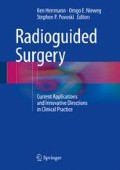Abstract
Radioguided surgery requires a significant amount of technology for its implementation. As a result, surgeons working in this field must have a basic know-how that extends beyond the standard surgical training and covers the relevant physics. Within this chapter we have tried to synthesize the background knowledge needed for a complete understanding of the most important aspects and processes. The terminology and the explanations target people just starting in the field, and the contents should prove readily intelligible as long as the complete chapter is read.
Access this chapter
Tax calculation will be finalised at checkout
Purchases are for personal use only
Notes
- 1.
Today’s physics distinguishes four major independent interactions: gravitation, electromagnetism, and the two nuclear forces (the weak and the strong).
- 2.
The term “radioactivity” derives from Marie Curie [1], who discovered this process in radium, which was among the first elements to be discovered by her and her husband, Pierre, at the turn of the nineteenth century.
- 3.
As mentioned above, radioactivity is an independent fundamental interaction.
- 4.
The unit Becquerel honors the discoverer of radioactivity, Henri Becquerel [1].
- 5.
In honor of Marie and Pierre Curie, pioneers in the understanding of radioactivity
- 6.
Effect named after Pierre Auger, who in 1923 discovered it independently from Lise Meitner, who was the first to report on it shortly beforehand in 1922 [5]
- 7.
The first explanation of the photoelectric effect in terms of currently accepted physics comes from Albert Einstein [6].
- 8.
In honor of Arthur H. Compton, who first observed and reported this in 1923 [7]
References
Curie E. Madame Curie: a biography. Reissue edition. Da Capo Press; 2001. ISBN-13 978-0306810381.
Ekström LP, Firestone RB. WWW table of radioactive isotopes. Database version 2/28/99 from URL http://ie.lbl.gov/toi (Nuclide Search).
Carsten J. Controversy and consensus: nuclear beta decay 1911–1934. Birkhäuser Verlag; 2000. ISBN: 3-7643-5313-9.
Alvarez LW. The capture of orbital electrons by nuclei. Phys Rev. 1938;54:486–97.
Duparc OH. Pierre Auger – Lise Meitner: comparative contributions to the Auger effect. Int J Mater Res. 2009;100(09):1162.
Einstein A. Über einen die Erzeugung und Verwandlung des Lichtes betreffenden heuristischen Gesichtspunkt. Ann Phys. 1905;17(6):132–48.
Compton AH. A quantum theory of the scattering of X-rays by light elements. Phys Rev. 1923;21(5):483–502.
Knoll GF. Radiation detection and measurement. 4th ed. Wiley; 2010. ISBN-13 978-0470131480.
Bardach H, Wisnieff S. The evolution of a radiologic measuring technique – innovative metrology – key to progress. Standards Laboratory Conference; NBS Special Publication 1970;13:11–21.
Katz L, Penfold AS. Range-energy relations for electrons and the determination of beta-ray end-point energies by absorption. Rev Mod Phys. 1952;24:28.
Hakamata T, et al. Photomultiplier tubes, basics and applications – Hamamatsu Photonics KK. 3rd ed. 2007.
Datasheets of crystals taken from the website of Saint-Gobain Ceramics & Plastics, Inc. http://www.crystals.saint-gobain.com/.
Mestais C, Baffert N, Bonnefoy JP, Chapuis A, Koenig A, Monnet O, Ouvrier Buffet P, Rostaing JP, Sauvage F, Verger L. A new design for a high resolution, high efficiency CZT gamma camera detector. Nucl Inst Methods Phys Res A. 2001; 458(1–2):62–7.
Lide DR, editors. CRC handbook of chemistry and physics. 84th ed. Section 4: Properties of the elements and inorganic compounds; physical properties of the rare earth metals. Boca Raton: CRC Press; 2003.
Lombardi MH. Radiation safety in nuclear medicine. 2nd ed. CRC Press; 2006. ISBN-13 978-0849381683.
Author information
Authors and Affiliations
Corresponding author
Editor information
Editors and Affiliations
Rights and permissions
Copyright information
© 2016 Springer International Publishing Switzerland
About this chapter
Cite this chapter
Wendler, T., Eberlein, U., Lassmann, M. (2016). Physics of Radioguided Surgery: Basic Principles and Methods of Radiation Detection. In: Herrmann, K., Nieweg, O., Povoski, S. (eds) Radioguided Surgery. Springer, Cham. https://doi.org/10.1007/978-3-319-26051-8_2
Download citation
DOI: https://doi.org/10.1007/978-3-319-26051-8_2
Published:
Publisher Name: Springer, Cham
Print ISBN: 978-3-319-26049-5
Online ISBN: 978-3-319-26051-8
eBook Packages: MedicineMedicine (R0)

